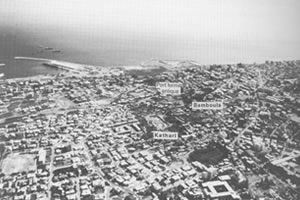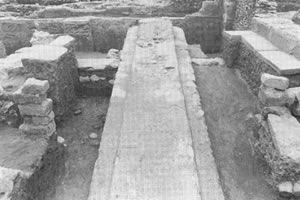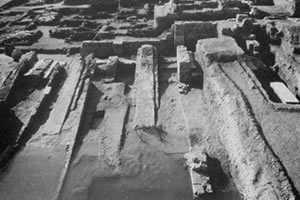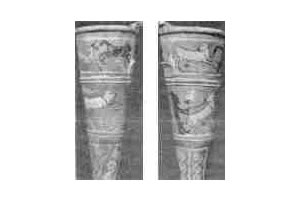Η Ιστορία του αρχαίου ΚιτίουΤο Κίτιο, ιδρύθηκε από Έλληνες αποίκους περίπου τον 14ο π.Χ. αιώνα. Υπήρξε αργότερα σημαντική αποικία των Φοινίκων. Είναι, μεταξύ άλλων, γνωστό από την εκστρατεία του Κίμωνος του Αθηναίου, ο οποίος πέθανε ενώ πολιορκούσε το Κίτιο. Η περιοχή γύρω από την πόλη του αρχαίου Κιτίου κατοικείται ήδη από την Νεολιθική και Χαλκολιθική περίοδο (Άρπερα, Κίτι, Κλαυδιά), ενώ στην Ύστερη Εποχή του Χαλκού ακμάζει ο σημαντικός οικισμός στη θέση Χαλά Σουλτάν Τεκκέ, και χρησιμοποιεί ως λιμάνι, τη σημερινή αλυκή, η οποία έχει σ΄αυτή την περίοδο έξοδο στη θάλασσα, αποτελώντας έτσι ασφαλές εσωτερικό λιμάνι.
Αυτό μαρτυρείτε από τις λίθινες άγκυρες που έχουν εντοπιστεί στην περιοχή και από την αρχαιολογικά τεκμηριωμένη επαφή με την Εγγύς Ανατολή, την Αίγυπτο και το Αιγαίο. Κατά το τέλος της Ύστερης Εποχής του χαλκού (13ος αι.π.Χ.) το λιμάνι της αλυκής εγκαταλείπεται, μάλλον λόγω της επίχωσης της εισόδου του.
Έτσι η πόλη μετακινείται προς τα βόρεια, με επίκεντρο την περιοχή της Παμπούλας, όπου υπήρχε μικρός κλειστός κόλπος, ο οποίος μπορούσε να χρησιμοποιηθεί ως νέο λιμάνι. Αρχικά το Κίτιον οργανώνεται ως μυκηναϊκή πόλη με κυκλώπεια τείχη, ιερά, διοικητικό κέντρο, εργαστήρια επεξεργασίας χαλκού κλπ.
Ως επιδέξιοι ναυτικοί και έμποροι οι Φοίνικες αναπτύσσουν το Κίτιον και καταφέρνουν στην Κλασική περίοδο να προσαρτήσουν το βασίλειο του Ιδαλίου και να αγοράσουν το βασίλειο της Ταμασσού για την εκμετάλλευση του χαλκού τους. Οι εισαγωγές αγαθών επιβεβαιώνονται από σφραγίδες αμφορέων από τη Θάσο, Xίο, Pόδο, Kνίδο, κεραμική από την Aθήνα, Φοινίκη, Pόδο, παστά ψάρια από την Aίγυπτο κλπ. Η εμπορική κίνηση της πόλεως συναντάται σε διάφορες αρχαίες πηγές, όπως ο Δημοσθένης και ο Λυσίας, καθώς και επιγραφές, οι οποίες αναφέρουν το Kίτιο σαν χώρο εμπορικής δραστηριότητας και τους Kιτιείς ως εμπόρους εγκαταστημένους σε διάφορα μέρη, όπως η Δήλος, η Δημητριάδα, η Ρόδος και ο Πειραιάς. Πηγή: http://www2.rgzm.de/Navis2/Harbours/Athen/Kition/KitionGR.htm History Of ancient KitionThe Kition, was founded by Greek colonists around the BC 14 century. He was later an important colony of the Phoinikans. It is also known by the campaign of Kimonos the Athenian who died while fighting for Kition. The capital of the kingdom of Kition is located at the centre of the present town of Larnaca, in the area of Pamboula, where the ancient naval port was found. The rural area of the kingdom extended around the district of Larnaca between the areas of the kingdoms of Salamis, with which existed a continual rivalry, and of Αmathous. The district around the town of ancient Kition was inhabited from the Neolithic and Chalcolithic period (Άρπερα, Κίτι, Κλαυδιά), and during the Late Bronze Age the important settlement of Hala Sultan Tekke flourished.
This city used as its harbour the present day salt-pan lake, which during this period had an exit to the sea thus ensuring a safe port Evidence of the harbour and its use is indicated by the stone anchors that have been recovered in the area, and by the excavated materials that highlight the connection with the Near East, Egypt, and the Aegean. At the end of Late Bronze Age (13th century BC) the lake-port was abandoned, most probably due to the silting of its. For this reason the city was moved towards the north, having as a centre the district of Pamboula, were there was a small bay which could be used as the new harbour. Kition was organised as a Mycenaean city comprising cyclopian walls, sanctuaries, an administrative centre, and workshops for the exploitation of copper, however the city declined in the 11th century BC during the period of unrest and turmoil that characterises this period. In the 9th Century BC Phoinician traders who may have originated from Tyre settled in the city, and by the middle of the century political power of the city and the surrounding area was firmly under their control, thus establishing the first colony west of Phonecia. Kition remained under a Phoinician King until the Hellenistic period, and throughout its history it mostly supported other powers that were adverse to the surrounding Greek Kingdoms.
As skilful seamen and traders the Phoenicians of Kition advanced the city’s interests, and in the Classical period, to incorporate the kingdom of Idalion and buy the kingdom of Tamassos for the exploitation of their copper. The imports of products are attested to by the stamps on amphoras from Thasos, Chios, Rhodes, Knidos, and pottery from Athens, Phoenicia, Rhodes, and salted fish from Egypt. The commercial nature of the town is mentioned by various ancient sources, such as Dimosthenes and Lisias, and inscriptions, which mention Kition as the place of commercial activity, and Kitians as traders settled in various parts, such as Delos, Dimitrias, and Pireaus. Resources:
|
Main Area
Main
2026 Aek. All rights reserved.
Designed & Developed by Ideaseven.





